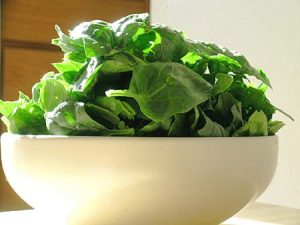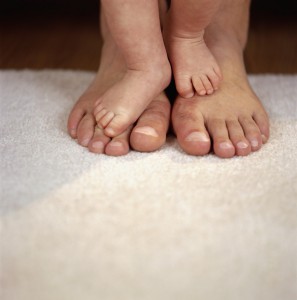FEATURED ARTICLES
- Details
- Written by Lisa Jillanza
Sure, you would be hard-pressed to find a woman or a man who says that they enjoy the thoughts of spring cleaning. But, if you just take into consideration how many calories are burned while you are doing your spring cleaning, then you may be a little more excited when spring rolls around this year.
 Spring Cleaning Workout
Spring Cleaning Workout
The actual number of calories burned will depend on your weight, gender and age, but their calculators that you can find online (FitDay or NutriStrategy) that will help you to calculate your actual calories burned.
So, dust off your mops, break out the cleaner and begin to sweat off the weight!
Editor's Note: The calories burned estimates listed here are based on one hour of cleaning for a 155-pound woman.
Gardening: 226 calories
Window washing: 226 calories
Scrubbing floors (on hands and knees): 291 calories
Laundry, ironing: 84 calories
Sewing repairs: 36 calories
Dusting: 97 calories
Scrubbing toilets, tub: 246 calories
Vacuuming: 317 calories
Cleaning gutters: 258 calories
Moving furniture, household items: 387 calories
Painting, papering, plastering: 317 calories
Sweeping: 194 calories
Mopping: 153 calories
Mowing the lawn: 148 calories
Washing dishes: 77 calories
- Details
- Written by Lisa Jillanza
The vitamin K in spinach provides 200% of the daily value in fresh spinach and nearly 1000% of the daily value in boiled spinach.
Spinach is an excellent source of vitamin C and vitamin A, folate and magnesium.
Cooked spinach is a great source of iron and is totally fat free.
 Healthy Spinach Recipes
Healthy Spinach Recipes
Recipe: Wilted Spinach Salad
- 10 to 12 ounces spinach, washed and torn into pieces
- ¼ cup minced red onion
- 5 to 6 radishes, thinly sliced
- 2 hard-cooked eggs, 1 chopped and 1 sliced
- 2 to 4 slices bacon
- 1 to 1 ½ tablespoons bacon drippings
- 1 ½ tablespoons sugar
- 3 tablespoons vinegar
- 1 tablespoon water
- ½ teaspoon salt
- 1/8 teaspoon pepper
Place prepared spinach in a large bowl. Add onions and radishes. Refrigerate, tightly covered. Fry or microwave bacon until crisp; remove to paper towel and set aside. In a small jar or measuring cup combine drippings with sugar, vinegar, water, salt and pepper. Refrigerate all ingredients until just before serving. When ready to serve, microwave the dressing on high for 30 to 45 seconds, or until mixture boils. Toss the chopped egg with the greens then pour the hot dressing over greens mixture; toss again lightly. Top with sliced egg and crumbled bacon.
Recipe: Spinach Lasagna
- 2 egg whites
- 26 oz of prepared spaghetti sauce
- 24 oz of ricotta cheese
- 10 oz of Lasagna noodles, cooked
- 10 oz of frozen spinach, thawed and chopped, then squeezed dry
- 2 cups of mozzarella cheese, grated, reserve ½ cup
- ¾ cup of Parmesan cheese, grated and divided, reserve 2 tablespoons
- ½ teaspoon of salt
- ½ teaspoon of black pepper
- Olive oil
Preheat oven to 350°. Prepare a 9x13 dish.Cook lasagna noodles as directed on the package, then rinse and drain. Combine parmesan cheese, ricotta cheeses with the egg whites, salt and pepper in a large mixing bowl. Pour ¼ cup of spaghetti sauce in the bottom of the baking dish and spread it out using a spatula. Cover the sauce with a single layer of lasagna noodles. Spread about half the cheese mixture over the noodles, and then cover with about half of the spinach and shredded mozzarella cheese. Finish this layer with half of the remaining spaghetti sauce. Add a second layer of noodles, topping with the remaining cheese mixture, spinach, and mozzarella cheese. Top with the final layer of noodles and remaining spaghetti sauce. Sprinkle the reserved Parmesan cheese over the top and bake for 30 minutes. Remove from oven and set for 10-12 minutes.
- Details
- Written by Lisa Jillanza
As the ice and snow start to melt and the mercury starts to rise again, everyone starts to think about getting back in shape for the spring and summer seasons. Instead of hitting the exercise hard, many experts suggest easing back into your springtime routine
 Healthy Spring Tips
Healthy Spring Tips
Start Slow. Take the time you need to jump start your spring diet and exercise plan. By easing into your regimen, you will be more successful in keeping with your diet and exercise plan.
Plan a New Menu. You need to really look at your diet and the number of calories you are consuming daily. Choose foods that are low in calories but are filling to help you fight off the hunger throughout the day.
Get outdoors. Now that the weather is breaking, mix up your exercise routine and enjoy the weather outdoors. Walk, hike, bike, run , enjoy yourself and the beautiful season.
- Details
- Written by Lisa Jillanza
As odd as it may seem, your feet may be the window to your overall body health. Here are some things to look for regarding your feet that will give you clues that there may be other important body issues to look into.
 Toes, Signs and Symptoms
Toes, Signs and Symptoms
Thick, yellow toenails -
Toenails are not supposed to be thick and/or yellow. Thick, yellow nails are most often an indication of a fungal infection living beneath your toenails. People that have other medical conditions, like rheumatoid arthritis, diabetes and other immune deficiencies are more likely to get a fungal infection than those that do not have these conditions. To treat thick, yellow toenails, you will need to consult a podiatrist. While there are plenty of over-the-counter treatments for thick, yellow toenails, by the time your nails are already discolored and thick it is too late for any over-the-counter creams or medicines to work. You must discuss your options with a professional.
No hair on your feet or toes :
If your feet or toes are lacking hair, it can be a sign of having poor circulation because of vascular disease. If you notice that your feet and toes do not have any hair on them, you will want to consult your doctor to find out ways to improve your circulation thereby reducing your risk of acquiring vascular disease.
A wound that won't heal on your foot : Wounds on your feet that just won't heal could be an indication of diabetes. Over time, elevated blood glucose levels can lead to serious nerve damage in your feet and because of this damage you may not feel when you have a sore or a wound on your foot. If your wound continues to go unhealed there could be major problems, including amputation. If you notice a wound that won't heal on your feet be sure to contact your doctor to discuss your wound. If you are currently living with or being treated for diabetes, be sure to check your feet often and mark any changes.
- Details
- Written by Lisa Jillanza
It's a well-known fact that being overweight increases your chance of being at risk of a number of chronic diseases, including high blood pressure, stroke, and cardiovascular disease. But research shows that even a small amount of weight loss can lessen your risk of falling victim to these deadly diseases.
 Heart Awareness Month
Heart Awareness Month
Research also shows that, unfortunately, eating just 100 more calories a day than you should, can cause your body weight to be in the obese category and not just the overweight category.
To determine whether or not you are overweight or obese, use a BMI Calculator. A BMI between 25 and 29.9 is considered overweight; a BMI between 30 and 39.9 is considered obese.
If your BMI is greater than 25 and you are older than 30 years old, you should strongly consider losing weight to reduce your risk of heart disease and other life-threatening conditions.
In recognition of American Heart Month here are some important statistics regarding heart health:
- Heart disease is the leading cause of death in the United States.
- Approximately 1.5 million heart attacks and strokes occur every year in the United States.
- The average age for a first heart attack for men is 66 years.
- Many cases of heart disease can be prevented. Learn more at cdc.gov.

